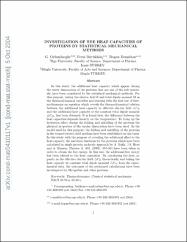| dc.contributor.author | Oylumluoğlu, Görkem | |
| dc.contributor.author | Büyükkılıç, Fevzi | |
| dc.contributor.author | Demirhan, Doğan | |
| dc.date.accessioned | 2020-11-20T16:37:39Z | |
| dc.date.available | 2020-11-20T16:37:39Z | |
| dc.date.issued | 2007 | |
| dc.identifier.issn | 0378-4371 | |
| dc.identifier.uri | https://doi.org/10.1016/j.physa.2006.09.023 | |
| dc.identifier.uri | https://hdl.handle.net/20.500.12809/5103 | |
| dc.description | WOS: 000243623700018 | en_US |
| dc.description.abstract | In this study additional heat capacity of the proteins in water dissociation have been investigated by statistical mechanical methods. For this purpose, taking electric field E and total dipole moment M as thermodynamical variables and starting with the first law of thermodynamics, an expression which reveals the thermodynamical relation between additional heat capacity in effective electric field Delta C-E and additional heat capacity at the constant total dipole moment Delta C-M, has been obtained. It is found that, difference between the heat capacities depends linearly on temperature. To establish the hydration effect during the folding and unfolding of the proteins, physical properties of the apolar dissociation have been used [G. Oylumluoglu, et al, Physica A 361 (2006) 255-262]. In the thermodynamical investigation of the protein system, in order to introduce the chemical potential mu (here it takes place of pH), one has to consider the system as a macro-canonical ensemble. In this study, the macro-canonical ensemble is obtained from the canonical ensemble. In this approach the proteins are taken in a heat bath, and also it is supposed that the system is in a particle reservoir. When this reservoir reaches to an equilibrium the number of particles take an average value. In this study, with the purpose of revealing the additional effect to the heat capacity, the partition functions of the proteins obtained in single protein molecule approach are taken. In this way, additional free energy has been related to heat capacities. Calculating the heat capacity Delta C-E and taking the heat capacity at constant total dipole moment Delta C-M from the experimental data, the outcomes of the performed calculations have been investigated for Myoglobin and other proteins. (c) 2006 Elsevier B.V. All rights reserved. | en_US |
| dc.item-language.iso | eng | en_US |
| dc.publisher | Elsevier Science Bv | en_US |
| dc.item-rights | info:eu-repo/semantics/openAccess | en_US |
| dc.subject | classical statistical mechanics | en_US |
| dc.title | Investigation of heat capacities of proteins by statistical mechanical methods | en_US |
| dc.item-type | article | en_US |
| dc.contributor.department | MÜ, Fen Fakültesi, Fizik Bölümü | en_US |
| dc.contributor.institutionauthor | Oylumluoğlu, Görkem | |
| dc.identifier.doi | 10.1016/j.physa.2006.09.023 | |
| dc.identifier.volume | 375 | en_US |
| dc.identifier.issue | 2 | en_US |
| dc.identifier.startpage | 577 | en_US |
| dc.identifier.endpage | 583 | en_US |
| dc.relation.journal | Physica A-Statistical Mechanics and Its Applications | en_US |
| dc.relation.publicationcategory | Makale - Uluslararası Hakemli Dergi - Kurum Öğretim Elemanı | en_US |


















